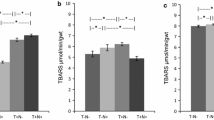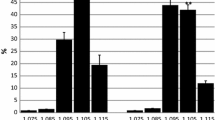Abstract
The purpose of this study was to follow the time course of metabolic responses to hyperadrenalinemia sustained up to 3 days. Hyperadrenalinemia was produced in rats by s.c. implantation of tablets releasing adrenaline (A) at a constant rate (1.6 μg x min−1). After 6, 12, 24 and 72 h of hyperadrenalinemia and 3 days after the tablet removal rats were sacrificed and liver, 3 types of muscles and blood samples were taken. Each time 14 rats were used: 7 of them were sedentary and 7 performed treadmill endurance exercise before decapitation. Sham operated animals served as controls. In preliminary experiments working ability was examined in 10 hyperadrenalinemic and 10 control rats. Duration of exercise until exhaustion was reduced in hyperadrenalinemic rats on the average by 40%. In sedentary rats, hyperglycemia, marked depletion of liver glycogen (by approx. 80%) and muscle glycogen (by 60–80%) as well as an elevation (2–4 times) of muscle lactate (LA) were found only during the first day after A-tablet implantation. At the end of the experiment these values approached the control ones. Muscle contents of ATP and creatine phosphate (CrP) were decreased by approx. 20% and 30–60%, respectively. Plasma FFA were markedly enhanced, varying in the time-course of the experiment from 0.8 to 1.4 mmol×1−1. Post-exercise values for blood glucose, liver and muscle glycogen were always lower in hyperadrenalinemic rats than in controls sacrificed after timematched exercise (30 min). Circulating FFA decreased during excercise at all time points following A-tablet implantation, but they were still above the post-exercise levels in sham-operated rats. The response of muscle adenine nucleotides to exercise was not uniform, and changes in their values in the time-course of hyperadrenalinemia paralelled those in circulating FFA.
It is concluded that during sustained hyperadrenalinemia some metabolic effects of adrenaline in sedentary animals are only transient, but impaired exercise tolerance persists for the whole time, being caused, at least in part, by early exhaustion of liver and muscle glycogen.
Similar content being viewed by others
References
Budohoski L, Challiss JRA, Dubaniewicz A, Kaciuba-Uściłko H, Leighton B, Lozeman FJ, Nazar K, Newsholme EA, Porta S (1987) Effects of prolonged elevation of plasma adrenaline concentration in vivo on insulin sensitivity in soleus muscle of the rat. J Biochim 244:655–660
Chasiotis D, Sahlin K, Hultman E (1983) Regulation of glycogenolysis in human muscle in response to epinephrine infusion. J Appl Physiol Respirat Environ Exercise Physiol 54:45–50
Chiasson JL, Shikama H, Chu DWT, Exton JH (1981) Inhibitory effect of epinephrine on insulin stimulated glucose uptake by rat skeletal muscle. J Clin Invest 68:703–713
Danforth WH (1965) Glycogen synthetase activity. Interconversion of two forms and control of glycogen synthesis. J Biol Chem 240:588–593
Egger G, Sadjak A, Porta S, Supanz S, Purstner P (1986) Laboratory handling and its influence on hormonal and metabolic parameters during acute inflamation in rats. A critique of longterm treatment by repeated injections. Horm Metab Res 18:746–749
Górski J (1978) Exercise-induced changes of reactivity of different types of muscle on glycogenolytic effect of adrenaline. Pflügers Arch 373:1–7
Gray DE, Lickley HLA, Vranic M (1980) Physiologic effects of epinephrine on glucose turnover and plasma free fatty acid concentrations mediated independently of glucagon. Diabetes 29:600–609
Harris RC, Hultman E, Nordesjo L-O (1974) Glycogen, glycolytic intermediates and high-energy phosphates determined in biopsy samples of musculus quadriceps femoris of men at rest. Methods and variance of values. Scand J Clin Lab Invest 33:109–129
Henning G, Lofler G, Wieland OH (1975) Active and inactive forms of pyruvate dehydrogenase in skeletal muscle as related to the metabolic and functional state of the muscle cell. FEBS Lett 59:142–145
Holmberg E, Waldeck B (1980) The effect of insulin on skeletal muscle contractions and its relation to the effect produced by β-adrenoreceptor stimulation. Acta Physiol Scand 109:225–229
Jansson E, Hjemdahl P, Kaijser L (1986) Epinephrine-induced changes in muscle carbohydrate metabolism during exercise in male subjects. J Appl Physiol 60:1466–1470
Korsatko W, Porta S, Sadjak A, Supanz S (1982) Implantierbare Adrenalin-Retardtabletten zur Langzeituntersuchung in Ratten. Pharmazia 37:565–567
Kozłowski S, Langfort J, Brzezinska Z, Pilis W, Kaciuba-Uściłko H, Nazar K, Porta S (1987) Prolonged hyperadrenalinemia impairs exercise ability in rats. Acta Physiol Pol 38:451–457
Kvetnansky R, Torda T, Dominiak P, Vigas M, Nemeth S, Grobecker H (1985) Stress induced changes in the adrenergic system. In: Ben-Jonathan N, Bahr JM, Weiner RI (eds) Catecholamines as hormone regulators. Raven Press, New York, pp 237–257
Le Blanc J (1975) Man in the cold. Thomas, Springfield, IL
Nesher R, Karl JE, Kipnis D (1980) Epitrochlearis muscle. II. Metabolic effects of contractions and catecholamines. Am J Physiol 239:E461-E467
Porta S, Egger G, Sadjak A, Supanz S, Purstner P, Hofler H (1983) Peculiar effects during controlled release adrenaline application in rats on insulin, glucose and pancreas. Front Horm Res 12: 1–5
Richter EA, Ruderman NB, Gavras H, Belur ER, Galbo H (1982) Muscle glycogenolysis during exercise: dual control by epinephrine and contractions. Am J Physiol 242:E25-E32
Sadjak A, Egger G, Klink E, Korsatko W (1984) Vasoconstriction of vasa afferentia in the rat kidney after long-term adrenaline application. Exp Pathol 25:19–25
Shikama H, Michio U (1975) Adrenergic receptor and epinephrine-induced hyperglycemia and glucose tolerance. Am J Physiol 229:962–966
Shimazu S, Inoue K, Tani Y, Yamada H (1979) Enzymatic microdetermination of serum free fatty acids. Anal Biochem 98:341–345
Stainsby WN, Sumners C, Andrew GM (1984) Plasma catecholamines and their effect on blood lactate and muscle output. J Appl Physiol: Repir Environ Exercise Physiol 57: 321–325
Tomaszewska L, Kaciuba-Uściłko H, Reklewska B, Sobocinska J, Kozłowski S (1971) Effect of immobilization on urinary catecholamine excretion and blood thyroxine level in rats. Space Life Sci 3:174–176
Williams RS, Caron MG, Daniel K (1984) Skeletal muscle β-adrenergic receptor variations due to fiber type and training. Am J Physiol 246:E160-E167
Author information
Authors and Affiliations
Additional information
This work was supported by the Polish Programme for Basic Research 06.-02.III.
Rights and permissions
About this article
Cite this article
Nazar, K., Kaciuba-Uściłko, H., Porta, S. et al. Dynamics of metabolic responses to prolonged elevation of circulating adrenaline in resting and exercising rats. Pflugers Arch. 413, 429–434 (1989). https://doi.org/10.1007/BF00584494
Received:
Revised:
Accepted:
Issue Date:
DOI: https://doi.org/10.1007/BF00584494




